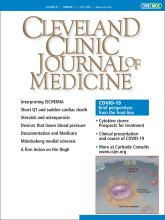Article Figures & Data
Tables
1 Confirm the diagnosis Blood pressure should be measured in an out-of-office setting using either ambulatory monitoring or home blood pressure monitoring to confirm diagnosis and to ascertain possible white coat effect. 2 Carefully review medications Review of medications should include over-the-counter medications such as nonsteroidal anti-inflammatory drugs and herbal medications, if any. 3 Explore the possibility of nonadherence to medications Nonadherence may be cost- or side-effect-related or due to complexity of regimen and poor understanding of medications. 4 Reinforce lifestyle modifications Guidelines for nonpharmacologic therapy from the American Heart Association and American College of Cardiology include a low-sodium diet, physical activity, weight management, and limited alcohol intake. Of note, although increased intake of dietary potassium is recommended for hypertension, this would not be feasible for patients with chronic kidney disease, who are prone to hyperkalemia. 5 Assess for secondary causes of hypertension 6 Ensure optimal doses and combination of antihypertensive medications Use thiazide-like diuretics such as chlorthalidone instead of hydrochlorothiazide. Use loop diuretics in states of volume overload or when the estimated glomerular filtration rate is less than 30 mL/min/1.73 m2. Dual renin-angiotensin blockade with angiotensin-converting enzyme inhibitor and angiotensin II receptor blocker is not recommended for hypertension as it has not been shown to improve cardiovascular outcomes or blood pressure control, and increases risk for acute kidney injury. Consider addition of spironolactone as a fourth-line agent; this may require use of potassium binding agents in patients to prevent hyperkalemia. Further stepwise treatment could include addition of beta-blockers, alpha-blockers, centrally acting alpha agonists, and direct vasodilators. Complex treatment regimens should take into account the possibility of increased side effects and risk of nonadherence, and care should be individualized, with close monitoring of renal function and electrolytes. 7 Refer to a hypertension specialist






